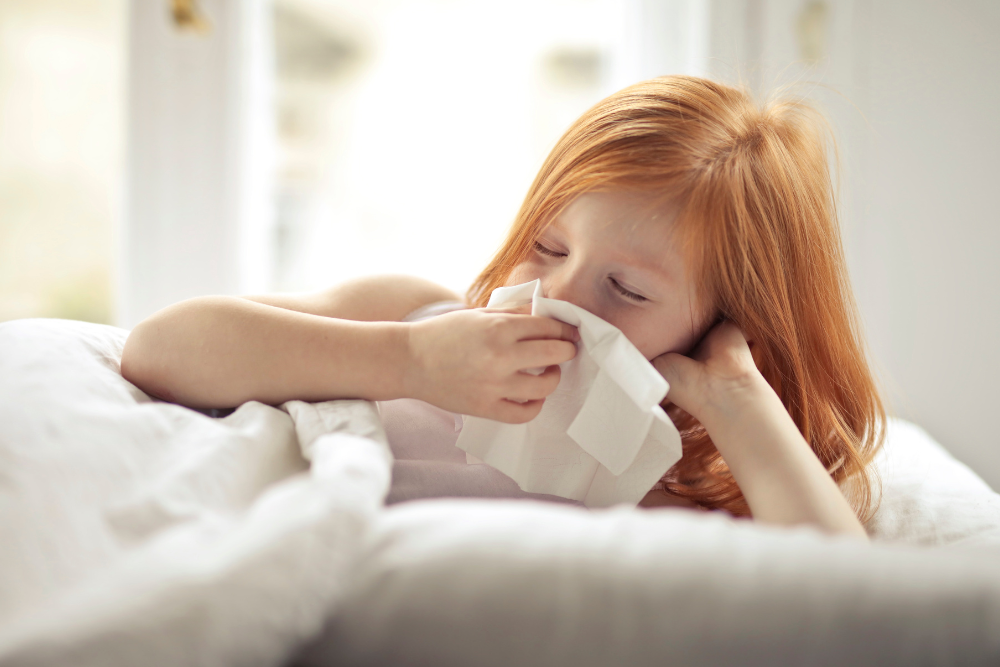Childhood is a magical time filled with laughter, curiosity, and boundless energy. However, it’s also a period when children are susceptible to various illnesses. As a parent or caregiver, it’s essential to be informed about common childhood illnesses so you can provide the best care for your sick child and protect yourself.
In this guide, we walk you through 10 common childhood illnesses, their causes, symptoms, and treatments. It’s time to safeguard your family’s health from childhood illness.
Head Lice
Head lice infestations are a frequent issue, particularly in school-age children. These tiny, parasitic insects live on the scalp, where they feed on blood. While not harmful to health, head lice can be bothersome and highly contagious. They are mostly found in hair near the scalp and lay small, oval eggs (nits) on hair shafts.
Head lice spread primarily through direct head-to-head contact, which is common among kids at school. Sharing personal items like combs, brushes, hats, or headphones can also contribute to the spread of head lice. Symptoms include itching on the scalp, neck, and ears caused by an allergic reaction to lice bites. Spotting lice or nits in the hair is also a telltale sign.
Treating Head Lice
To get rid of head lice, first, use a special lice shampoo from the pharmacy or grocery store. After that, comb through the hair with a fine-toothed comb to remove the dead lice and eggs. Do this combing every few days for a couple of weeks. Remember to wash all the bedding, clothes, and hats in hot water and give the carpets and furniture a good vacuum to pick up stray lice or eggs. If the lice don’t go away, you might need to talk to a doctor for stronger treatments.¹
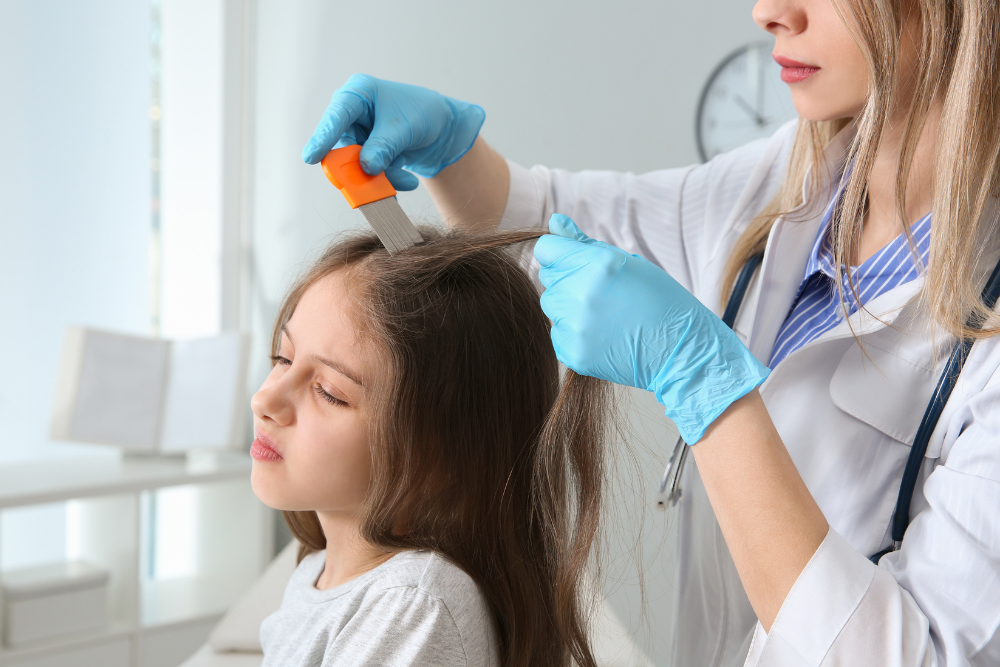
Gastroenteritis (Stomach Flu)
Gastroenteritis, often known as stomach flu or gastro, is common, especially in children and adults with weakened immune systems. This illness is caused by viruses, bacteria, or parasites infecting the stomach and intestines.
Gastroenteritis mainly spreads through contaminated food or water and close contact with an infected person. Poor hand hygiene can also play a significant role in its transmission. Symptoms typically include diarrhoea, vomiting, abdominal pain, and sometimes fever and headaches. Dehydration is a key concern, especially in young children and older people. How long does gastro last?
Treating Gastroenteritis
Most people recover from gastroenteritis on their own, but if it’s caused by bacteria or parasites, antibiotics may be necessary. Viral gastroenteritis does not require antibiotics. To manage symptoms, stay hydrated by sipping clear fluids frequently and avoid sugary drinks, which can worsen diarrhea. If you feel hungry, eat bland foods like crackers, rice, apple sauce or bananas. Rest is important, and continue breastfeeding if applicable. Consult a healthcare provider before taking anti-nausea or anti-diarrhoea medications, and avoid giving anti-diarrhea medicines to children. In cases of severe dehydration, intravenous fluids may be needed.²

Conjunctivitis
Conjunctivitis, commonly known as “pink eye” or “sticky eye” is an eye condition that affects people of all ages. It involves inflammation or infection of the conjunctiva, the transparent membrane lining the eyelid and covering the white part of the eyeball.
The causes of conjunctivitis vary; it can be viral, bacterial, or even allergic. Viral and bacterial conjunctivitis are highly contagious, spreading through direct contact with an infected person or through contaminated surfaces. Allergic conjunctivitis is caused by allergens like pet dander, pollen or dust mites.
Symptoms include redness in one or both eyes, itchiness, a gritty feeling in the eyes, discharge that forms a crust during the night, and tearing. Proper hygiene, avoiding touching the eyes, and not sharing personal items like towels can help prevent its spread.
Treating Conjunctivitis
Treating conjunctivitis depends on its cause. For all types, gently washing the eye with warm water several times a day can help. Viral conjunctivitis improves on its own without special treatment. Bacterial conjunctivitis may require antibiotic eye drops or ointment, which should be used even after symptoms improve. If you use disposable contact lenses, discard any used during the infection and replace the case. For extended-wear lenses, clean them as directed and avoid use for at least a week after symptoms resolve. Replace any eye makeup used before or during the infection. Allergic conjunctivitis is treated with antihistamine drops or tablets, and identifying the allergen may be necessary.³

Influenza (Flu)
Influenza, widely known as the flu, is a common respiratory illness affecting people of all ages. It’s caused by influenza viruses that infect the nose, throat, and sometimes the lungs. The flu can range from mild cold-like symptoms to severe or serious illness and complications, especially in high-risk groups like the elderly, young children, and those with certain health conditions.
Influenza spreads through tiny droplets made when people with the flu cough, sneeze, or talk. These droplets can land in the mouths or noses of people nearby or possibly be inhaled into the lungs. Less often, a person might also get the flu by touching a surface or object that has the virus on it and then touching their mouth, nose, or eyes.
Symptoms of the flu include fever, cough, sore throat, runny or stuffy nose, muscle or body aches, headaches, and fatigue. Some people may also experience vomiting and diarrhoea, though this is more common in children than adults.⁴
Treating Influenza
Most cases of mild flu can be managed at home, and most people recover within 7 to 10 days without treatment. To relieve flu symptoms:
- Get plenty of rest.
- Drink plenty of water and other non-alcoholic fluids to prevent dehydration.
- Keep warm.
- Eat a healthy diet with plenty of fruits and vegetables.
- Avoid exposure to cigarette smoke if possible.
- Inhale steam from a hot bath or shower in a closed room to help relieve a blocked nose (supervise children around hot water).
For a sore throat:
- Gargle with warm salty water.
- Suck on an ice cube, ice block, or throat lozenge.
- Drink hot water with honey and freshly squeezed lemon juice.
Several medicines can ease cold and flu symptoms, such as those for pain and fever. If you have the flu, stay home and avoid close contact with others until you feel better. Since the flu is caused by a virus, antibiotics will not help and can cause side effects such as upset stomach, diarrhea, and thrush. Using antibiotics unnecessarily also increases the risk of antibiotic resistance.⁴
⁴

Hand, Foot, and Mouth Disease (HFMD)
Hand, foot, and mouth disease is a viral illness that primarily affects children under 10 but can also occur in older children and adults.¹ It’s caused by viruses belonging to the Enterovirus group, most commonly the Coxsackie virus. This illness is known for being contagious but usually mild in nature.
The disease spreads through direct contact with an infected person’s nasal secretions, saliva, fluid from blisters, or stool. It’s also transmitted by touching contaminated objects or surfaces. Outbreaks are common in places like daycare centres and schools. Always consult a healthcare provider for the best treatment for your needs.
Symptoms include fever, sore throat, and reduced appetite at the onset. A day or two later, painful sores can develop in the mouth, and a rash with blisters may appear on the hands, feet, and sometimes the buttocks. Despite these symptoms, most children recover in 7 to 10 days.⁵
Treating Hand, Foot, and Mouth Disease
Treatment for this condition typically isn’t necessary, but paracetamol can help relieve fever and discomfort. It’s important not to give children aspirin. Allow blisters to dry out naturally without bursting them, as the fluid inside is infectious. Ensure that young children stay hydrated, as painful mouth sores might make them reluctant to drink fluids.⁵
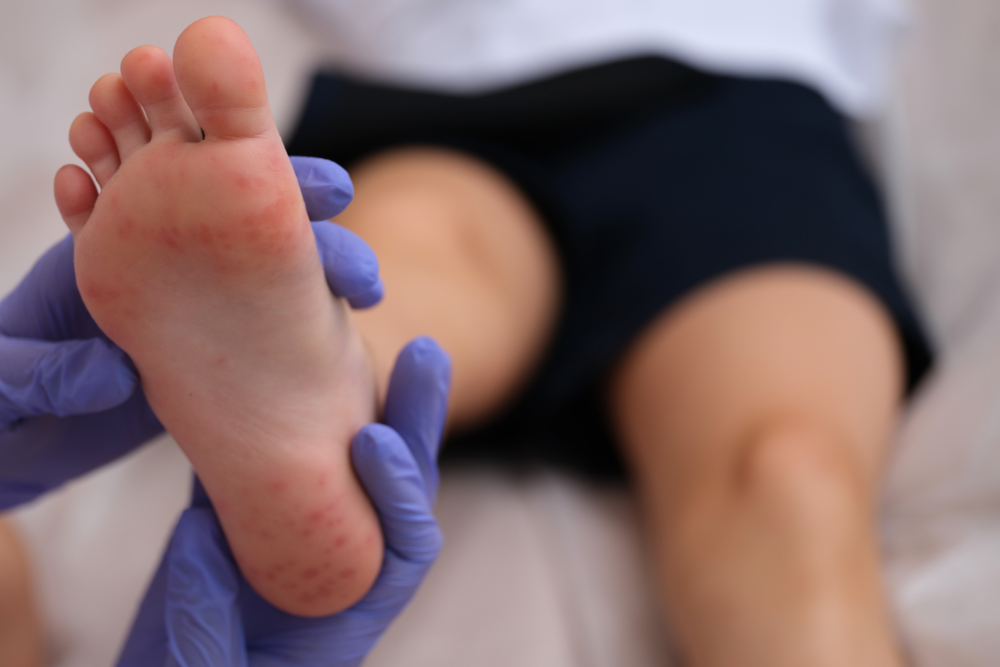
Strep Throat
Strep throat is a common bacterial infection primarily affecting school-aged children but can occur in people of all ages. It’s caused by the bacterium Streptococcus pyogenes, also known as group A streptococcus. Known for its rapid onset and contagious nature, strep throat is distinct from a typical sore throat caused by a cold.
This infection spreads through respiratory droplets when an infected person coughs or sneezes. It can also be picked up from surfaces or objects contaminated with these droplets and then touching the nose or mouth.
Symptoms of strep throat include a sudden, severe sore throat, pain when swallowing, fever, red and swollen tonsils, sometimes with white patches or streaks of pus, tiny red spots on the roof of the mouth, and swollen lymph nodes in the neck. Unlike a common cold, strep throat usually doesn’t cause a cough or runny nose. ⁶
Treating Strep Throat
The treatment for strep throat varies based on your risk of complications and the severity of your symptoms. Those at higher risk include individuals under 40, especially Aboriginal and/or Torres Strait Islander people, those in close contact with someone who has had rheumatic fever or heart disease, those in areas with high rates of rheumatic fever, and those living in crowded or disadvantaged conditions. This risk is particularly high for people aged 5 to 25.⁶
Antibiotics for Strep Throat
If your symptoms are severe or you have a high risk of complications, a doctor may prescribe antibiotics, which typically need to be taken for 5 to 10 days, depending on the type. It’s crucial to complete the entire course of antibiotics even if symptoms improve, to prevent recurrence. After starting antibiotics, you are usually no longer contagious after about 24 hours, and your symptoms may improve a day sooner compared to not taking the medication.⁶
Managing Strep Throat at Home
For those with manageable symptoms and low risk of complications, antibiotics may not be necessary. You can manage strep throat symptoms at home by:
- Drinking plenty of fluids like water, soup, and cold beverages.
- Eating soft, nutritious foods if swallowing is painful.
- Gargling with salt water.
- Sucking on lozenges or ice cubes.
- Avoiding speaking to rest your voice.
- Applying warm packs or compresses to your neck.
- Avoiding smoking and second-hand smoke.
If you have a fever, rest and limit your activities until it subsides. Consult with a doctor or pharmacist about taking paracetamol or ibuprofen to reduce fever and alleviate pain.⁶
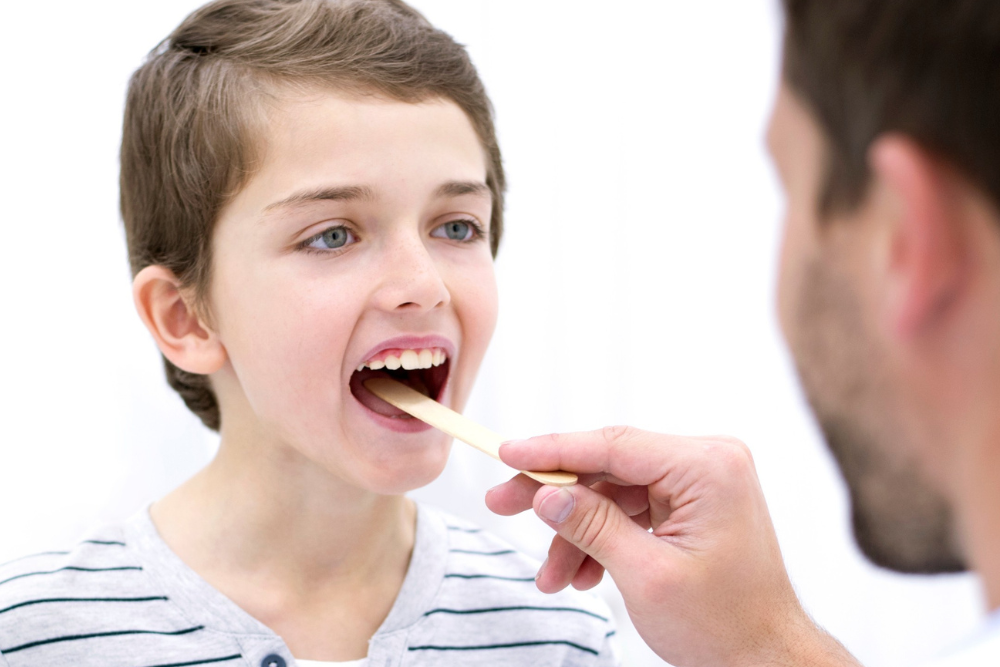
Bronchitis
Bronchitis is an inflammation of the bronchial tubes, the airways that carry air to your lungs. It often develops from a cold or other respiratory infection and is prevalent in adults and children. Acute bronchitis is usually caused by viruses, less commonly by bacteria, and tends to be temporary.
The infection spreads similarly to colds and flu, mainly through respiratory droplets when an infected person coughs or sneezes. It can also be contracted by touching surfaces contaminated with these droplets and then touching the face.
Bronchitis symptoms include a cough that produces mucus (which may be clear, white, yellow, or green), fatigue, shortness of breath, slight fever and chills, and chest discomfort. The cough can last several weeks, even after other symptoms have improved.⁷
Treating Bronchitis
Bronchitis is typically caused by a virus, making antibiotics ineffective since they do not kill viruses. The Australian Commission on Safety and Quality in Health Care provides a guide to help you and your doctor decide if antibiotics are necessary for acute bronchitis.
To ease your cough and other symptoms, consider the following self-care measures:
- Drink plenty of fluids.
- Get ample rest.
- Use simple pain relievers such as paracetamol or ibuprofen, following the label instructions.
- Take a teaspoon of honey at night, either alone or in warm water, to help soothe a cough. Do not give honey to children under 12 months of age.
- Avoid cigarette smoke and other irritants.
- Cough medicines are available, but their effectiveness may vary.
These steps can help manage symptoms and improve comfort during recovery.⁷
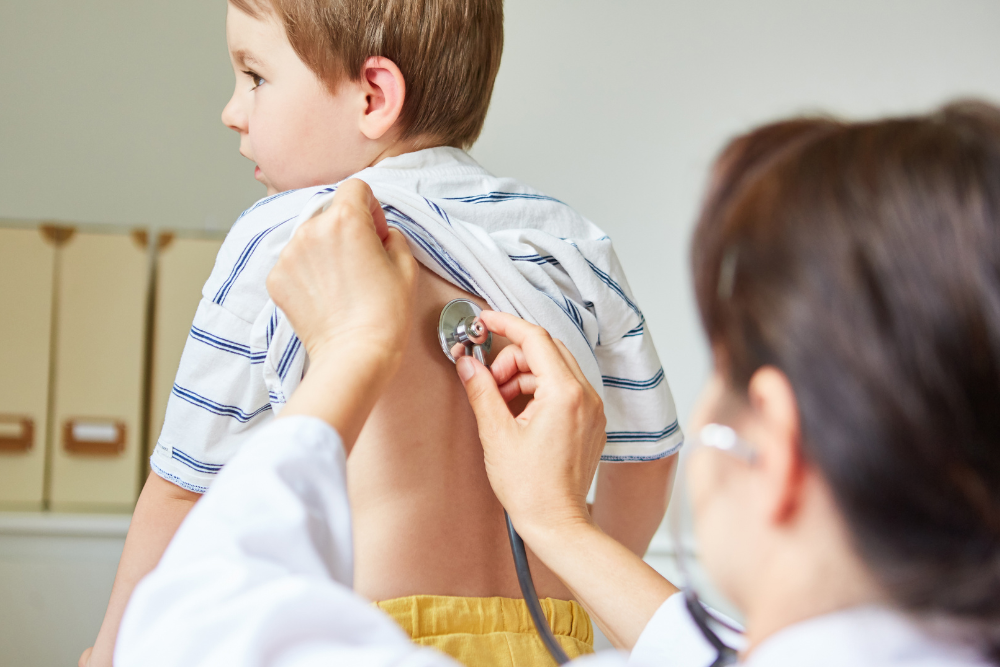
Glandular Fever
Glandular fever is a common viral infection usually caused by the Epstein-Barr virus (EBV). It’s sometimes known as the “kissing disease” due to its transmission through saliva, but it can also spread through respiratory droplets or sharing drinks and utensils. Glandular fever is most prevalent among teenagers and young adults, but anyone can get it.
The symptoms of glandular fever can vary and may include severe fatigue, fever, sore throat (often mistaken for strep throat if not tested), swollen lymph nodes in the neck and armpits, swollen tonsils, headache, and skin infection or rash. Some people might also experience an enlarged spleen or liver. Symptoms can range from mild to severe and typically develop four to six weeks after exposure to the virus.⁸
How is Glandular Fever Treated?
Glandular fever, also known as infectious mononucleosis, is a viral illness for which there is no specific treatment. Symptoms typically resolve on their own over a few weeks.
Self-Care Treatments
To help manage symptoms and aid recovery, consider the following self-care measures:
- Hydration: Drink fluids to stay hydrated. Avoid alcohol, as it can dehydrate the body.
- Rest: Get plenty of rest to support the body’s recovery process.
- Nutrition: Eat a balanced diet to maintain overall health.
- Pain and Fever Relief: Medications such as paracetamol and non-steroidal anti-inflammatory drugs (NSAIDs) can help relieve pain and reduce fever.
Important Note for Children
Children under the age of 16 should not take aspirin, as it may lead to a serious condition known as Reye’s syndrome.
By following these steps, individuals with glandular fever can alleviate discomfort and promote healing as the infection runs its course.⁸
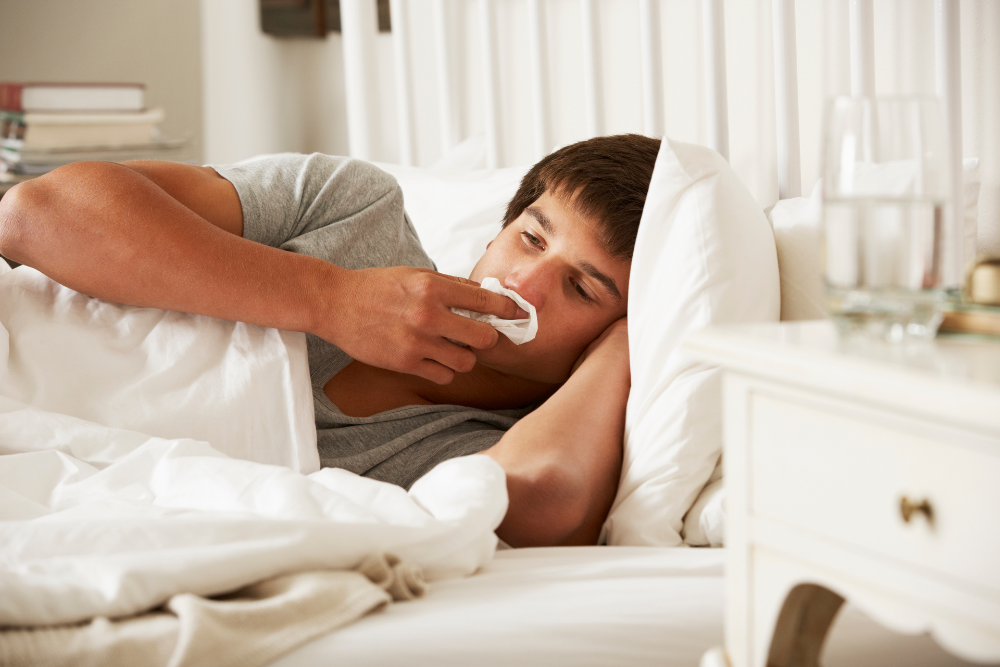
Ear Infection
Ear infections vary based on the part of the ear affected. The two most common types are middle ear infections (otitis media) and outer ear infections (otitis externa), and they can be caused by bacteria or viruses.
- Middle Ear Infections: The middle ear, located just behind the eardrum, connects to the throat via the Eustachian tube. During a cold, infections can travel up this tube to the middle ear. These infections are particularly common in babies and children because their Eustachian tubes are shorter and narrower.
- Outer Ear Infections: Also known as swimmer’s ear, these infections affect the ear canal and are often caused by water remaining in the ear after swimming. They can also occur due to damage to the ear canal, such as from using cotton buds.⁹
Treating Ear Infections
Middle Ear Infections (Otitis Media)
Most middle ear infections clear up on their own within a week. Pain relief medication like paracetamol or ibuprofen may be used if needed.
Antibiotics are not usually prescribed unless there are signs of severe illness, such as fever or vomiting. If symptoms persist after 1 to 2 days, it’s advisable to revisit the doctor.
Children under 2 years old, Aboriginal or Torres Strait Islander children, and those with certain medical conditions may be more likely to receive antibiotics due to higher risk of complications.
Outer Ear Infections (Otitis Externa)
Outer ear infections are typically treated with antibiotic ear drops that may also contain steroids. Lie down with the affected ear facing up when administering drops, and remain in that position for a few minutes.
Avoid swimming for about a week while the infection heals.
Why Antibiotics Aren’t Routinely Used for Middle Ear Infections
Middle ear infections often resolve on their own within about 4 days. On average, children who take antibiotics experience only about 12 hours less of ear pain compared to those who do not.
However, antibiotics can cause side effects and contribute to antibiotic resistance, which reduces their future effectiveness.
For more information, consult your doctor or visit the Australian Commission on Safety and Quality in Health Care website.⁹
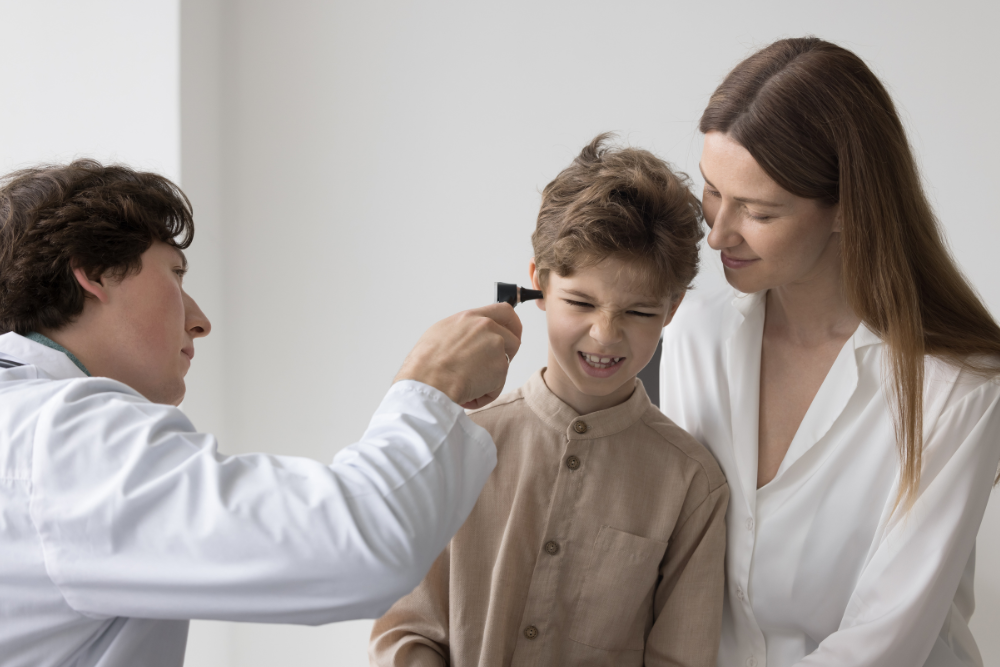
Chickenpox
Chickenpox, caused by the varicella-zoster virus, is a highly contagious infection affecting individuals of any age. Most cases are mild, with symptoms resolving quickly. However, in rare instances, serious complications such as pneumonia or meningitis can occur. The main symptom is an itchy red rash that progresses to fluid-filled blisters and eventually crusts over. Other symptoms may include fever, headache, and general discomfort. The rash typically appears about 2 weeks after exposure and can last from 10 days to 3 weeks. While more common in children, adults tend to experience more severe illness when infected with chickenpox.¹⁰
Treating Chickenpox
There is no specific treatment for chickenpox, as it is a viral infection caused by the varicella-zoster virus. Most cases are mild and resolve on their own within a short period. However, symptoms can be uncomfortable, especially the itchy blisters. It’s important to avoid scratching to prevent infection and scarring, which can be challenging, particularly for children. Keeping fingernails short may help reduce scratching.
You can alleviate symptoms by using soothing lotions and antihistamines for itching, and taking paracetamol following dosage instructions to reduce fever. Staying hydrated with water and getting plenty of rest are also beneficial. In severe cases or for individuals with weakened immune systems, antiviral medications may be prescribed by a doctor. Antibiotics are not effective against chickenpox because it is a viral illness, not bacterial.¹⁰
References
- Head lice | healthdirect. Available from: https://www.healthdirect.gov.au/head-lice [Accessed 13 June 2024].
- Gastroenteritis | healthdirect. Available from: https://www.healthdirect.gov.au/gastroenteritis [Accessed 13 June 2024].
- Conjunctivitis – treatment, symptoms and causes | healthdirect. Available from: https://www.healthdirect.gov.au/conjunctivitis-treatment [Accessed 13 June 2024].
- Flu (influenza) – symptoms, treatment and prevention | healthdirect. Available from: https://www.healthdirect.gov.au/flu [Accessed 13 June 2024].
- Hand, foot and mouth disease fact sheet – Fact sheets (nsw.gov.au). Available from: https://www.health.nsw.gov.au/Infectious/factsheets/Pages/hand-foot-and-mouth-disease.aspx [Accessed 13 June 2024].
- Strep throat – symptoms, treatment and prevention | healthdirect. Available from: https://www.healthdirect.gov.au/strep-throat [Accessed 13 June 2024].
- Bronchitis – symptoms and treatment | healthdirect. Available from: https://www.healthdirect.gov.au/bronchitis [Accessed 13 June 2024].
- Glandular fever – symptoms, causes and treatment | healthdirect. Available from: https://www.healthdirect.gov.au/glandular-fever [Accessed 13 June 2024].
- Ear infection – otitis media and otitis externa | healthdirect. Available from: https://www.healthdirect.gov.au/ear-infection [Accessed 13 June 2024].
- Chickenpox (varicella) – symptoms, treatment, vaccine | healthdirect. Available from: https://www.healthdirect.gov.au/chickenpox [Accessed 13 June 2024].


